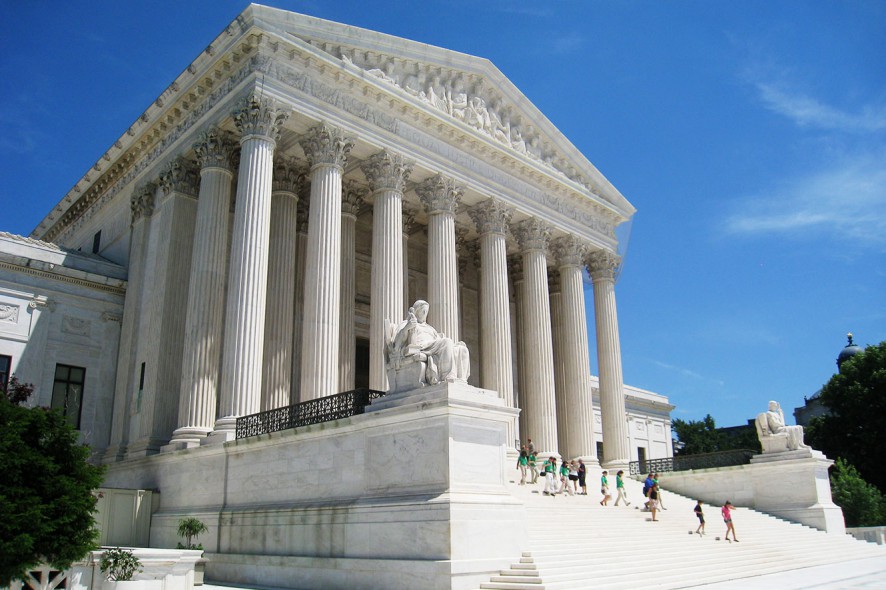Supreme Court of The United States: While deciding the patent dispute between Minerva Surgicals and Hologic Inc., the Court made certain significant observations with regards to the application of the doctrine of assignor estoppel. The Court held that the doctrine of assignor estoppel, which is grounded in the centuries-old fairness principles, applies only when the assignor’s claim of invalidity contradicts explicit or implicit representations he made in assigning the patent.
Facts and Contentions: In the late 90s, Csaba Truckai invented a device to treat abnormal uterine bleeding known as the NovaSure System. The system used a moisture-permeable applicator head to destroy targeted cells in the uterine lining. Truckai filed a patent application and later assigned the application, along with any future continuation applications, to his company, Novacept, Inc. The PTO issued a patent for the device. Novacept, along with its portfolio of patents and patent applications, was eventually acquired by Hologic, Inc.
In 2008, Truckai founded Minerva Surgical, Inc., where he developed a purportedly an improved device to treat abnormal uterine bleeding, called the Minerva Endometrial Ablation System. The new device used a moisture-impermeable applicator head to remove cells in the uterine lining. The PTO issued a patent, and the FDA approved the device for commercial sale. Meanwhile, Hologic filed a continuation application with the PTO, seeking to add claims to its patent for the NovaSure System. Hologic drafted one of its claims to encompass applicator heads generally, without regard to whether they are moisture permeable. The PTO issued the altered patent in 2015. Subsequently, Hologic sued Minerva Inc. for patent infringement.
It was Minerva’s contention that Hologic’s patent was invalid because the newly added claim did not match the invention’s written description, which addresses applicator heads that are water permeable. Minerva also argued that estoppel should not apply because it was challenging a claim that was materially broader than the ones Truckai had assigned. Hologic invoked the doctrine of assignor estoppel and contended that because Truckai had assigned the original patent application, he and Minerva could not impeach the patent’s validity.
The District Court, Court of Appeals and the Federal Circuit agreed with Hologic argument that assignor estoppel barred Minerva’s invalidity defense. Minerva thus appealed before the SCOTUS to either abandon or narrow the application of assigner estoppel.
Observations: The Court, with a ratio of 5:4 upheld the doctrine of assignor estoppel and also clarified the limits of the doctrine. The majority comprising of John Roberts, C.J., and Elena Kagan, Stephen Breyer, Sonia Sotomayor and Brett Kavanaugh, JJ., referred to the SCOTUS case of Westinghouse Elec. & Mfg. Co. v. Formica Insulation Co., 266 U. S. 342 (1924), wherein the Court approved the “well settled” patent-law doctrine of assignor estoppel. The Courts have applied the doctrine in order to deal with inconsistent representations about a patent’s validity as the doctrine limits an inventor’s ability to assign a patent to another for value and later contend in litigation that the patent is invalid.
The Majority disagreed with Minerva’s contention to abandon the doctrine. They noted that abandonment of the doctrine is not possible as it would foreclose applying in patent cases a whole host of common-law preclusion doctrines (a broad result that would conflict with this Court’s precedents) and subvert the Congressional intent of including assignor’s estoppel in the US law. The Court further observed that the Supreme Court’s precedents have never decided the fate the doctrine but rather suggested that the doctrine “needed to stay attached to its equitable moorings”.
The Majority further noted that, “Assignor estoppel reflects a demand for consistency in dealing with others. When a person sells his patent rights, he makes an (at least) implicit representation to the buyer that the patent at issue is valid. In later raising an invalidity defense, the assignor disavows that implied warranty. By saying one thing and then saying another, the assignor wants to profit doubly”. Such a course of conduct, as per the Majority, is, unfair dealing, and the need to prevent such unfairness outweighs any loss to the public from leaving an invalidity defense to someone other than the assignor.
Assignor Estoppel- Limitations: Shedding light on the limitations of the doctrine of assignor’s estoppel, the Court observed that-
- It applies only when its underlying principle of fair dealing comes into play. “The principle demands consistency in representations about a patent’s validity. When an assignor warrants that a patent claim is valid, his later denial of validity breaches norms of equitable dealing. But when the assignor has made neither explicit nor implicit representations in conflict with an invalidity defense, then there is no unfairness in its assertion—and so there is no ground for applying assignor estoppel”.
- When a later legal development renders irrelevant the warranty given at the time of assignment.
- A post-assignment change in patent claims can remove the rationale for applying assignor estoppel. As per the majority, this situation arises when most often when an inventor assigns a patent application, rather than an issued patent. The assignee may return to the PTO to enlarge the patent’s claims, assuming that the new claims are materially broader than the old ones, the assignor did not warrant to the new claims’ validity.
Amy Coney Barret, J., (along with Neil Gorsuch and Clarence Thomas, JJ.) and Samuel Alito, J., filed their dissenting opinions.
[Minerva Surgical Inc. v. Hologic Inc., No. 20–440, decided on 29-06-2021]
Sucheta Sarkar, Editorial Assistant ahs reported this brief.







